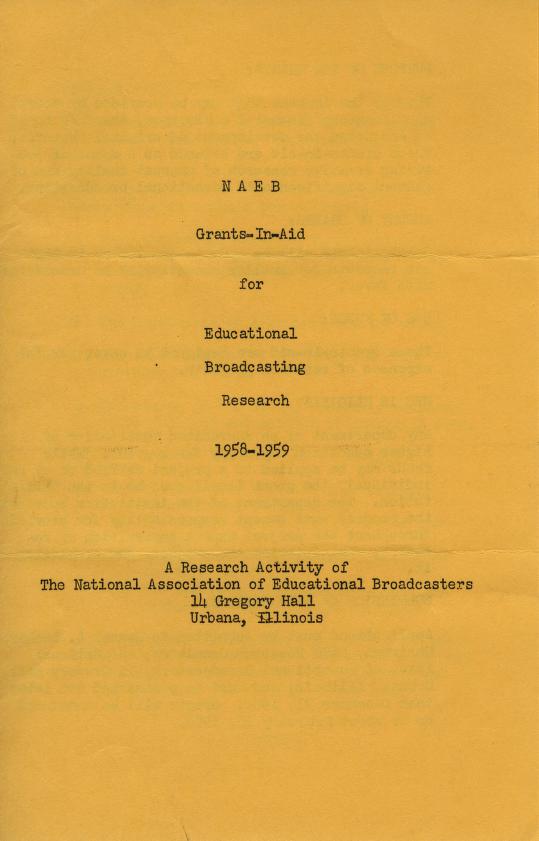In these days of escalating protest against America’s repressive racial system – a protest enabled by our current diversified and wildly unregulated digital media universe – listening to an NAEB program produced in 1961 is a poignant and sometimes infuriating reminder of how much has changed, and how much hasn’t, since television’s early years. Produced in the wake of the late 1950s quiz show and payola scandals, the series Ethic for Broadcasting seeks to puzzle out how radio and television might be reformed to better serve the needs of the American public during tumultuous times.
Produced by Wayne State University’s station WDET in Detroit in the fall of 1961, funded by a grant from the NAEB, Ethic for Broadcasting’s 13 episodes are compiled from interviews and organized by theme. After an “Introduction to the Series,” two programs each focus on television’s varied constituencies: “Broadcaster of the Art,” “Audience for the Art, “ “Advertiser of the Art,” “Lawmaker of the Art,” and a three-part “Critic of the Art” (broken down into “Religion,” “Education,” and “The Critic”), followed by a “Summary and Conclusion” episode.
Among the better-known names featured are broadcasters Mike Wallace, David Brinkley, David Susskind, and Sylvester “Pat” Weaver; FCC commissioner Newton Minow, and “Blue Book” author Charles A. Siepmann, with others drawn from business, journalism, education, and the clergy.
As the show’s introduction explains:
At present a few radio and TV network executives and advertising account men have the job of determining what you and 100 million other Americans will see and hear every night in your homes. The Federal Communications Commission, composed of seven political appointees, is charged with policing a billion-dollar industry earmarked “public interest.” Why then were rigged TV quizzes, payola, and FTC investigations of false advertising the rule last year? Who will determine an ethic for future broadcast programming?
The program lets its chosen interlocutees weigh in not only on the scandal but on how television might be improved more generally, and what role it should play in American public life. Advertisers point the finger of blame at the audience, broadcasters castigate the advertisers, and educators – many of them involved in educational broadcasting – call for more responsible oversight.
Looking back from our current point in time, the observations of three of the participants seem more prescient than others. Pat Weaver, former head of programming at NBC, diagnosed what he saw as the basic problem of the sponsor-dominated broadcasting model:
The complete control over broadcasting in this country rests with the networks – they really have all the control. Therefore they have to step up and take responsibility… We will not have a literate, civilized, balanced service in the country without the networks dedicating themselves to being something more than simply the pipes through which anybody’s stuff flows. They must be the editor as well as the printing press, they must run the business.
Indeed, the shift from sponsor to network control was already underway.
Charles Siepmann, formerly with the BBC and for many decades director of New York University’s communications program, a long-time advocate of public television, advised:
Use federal funds to activate the 258 frequencies that have been reserved for educational broadcasting and bring in… an alternative service… a fresh network financed sufficiently by federal funds, but without federal control, to operate educationally and to fill in… what the commercial broadcaster leaves out.
Already the NAEB was hard at work pulling together an educational television network that would become the backbone of PBS in the 70s.
But newspaper columnist Martin Chiles may have put his finger on the direction we seem to have taken in recent decades: “The public might very well prefer pay television…where they could get the programs they want and pay for them.”
Listening back to the program today, Ethic for Broadcasting is perhaps most notable for what and whom are left out. In 1961, civil rights activists marched, the women’s movement began to stir, the New Left organized, and the US expanded its military and espionage efforts in Vietnam. None of these events receives even a brief mention across the series’ more than 6 hours, while its roster of more than 26 “experts” – all white, all male, all denizens of the professional upper middle class – instead bemoan the “vulgar commercialism” and “decline in moral standards” of American society and call for stricter regulation and oversight – by, presumably, other white professional men. The idea that a wider range of perspectives might have created a more valid critique was clearly outside the program’s grasp. Whether it’s in commercial or public media, a diversity of voices and an engagement with the systemic inequalities and movements for social change should be central to any ethic for broadcasting.
Michele Hilmes

A brochure for the NAEB grants-in-aid program, which funded the production of series like Ethic for Broadcasting.